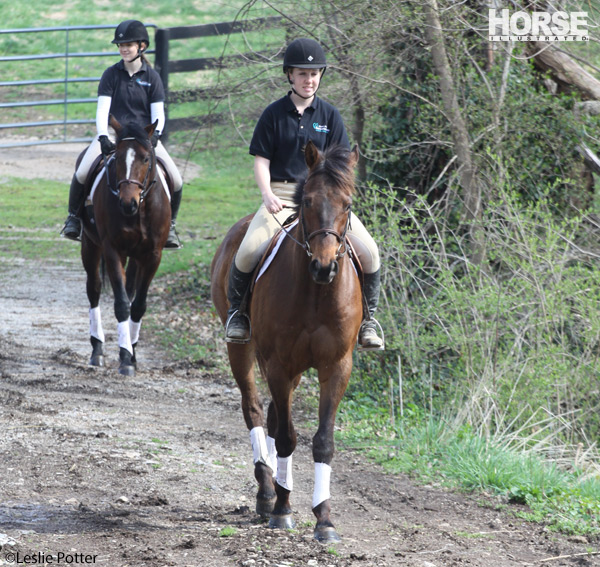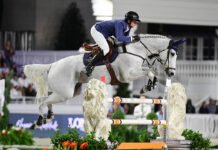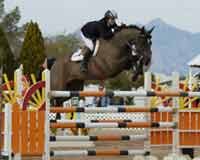Thoroughbred racehorses have been quietly transitioning from the track to lucrative second careers such as jumping, dressage and pleasure riding for as long as they’ve been around. However, the recent scrutiny on horse slaughter and “unwanted” horses has helped create a boom in the formation of Thoroughbred adoption agencies that help ex-racers make the shift from life on the track to a slower-paced career in other disciplines.
While you may opt to go through the regular horse-buying channels to purchase an off-the-track Thoroughbred (OTTB) that has been in a second career for a while, adopting a horse more recently off the track appeals to many prospective owners for various reasons. Of course, they are generally much more affordable than a horse that has been extensively trained and shown in a new discipline. But more than that, many riders seek the rewarding feeling of taking a horse nearly from scratch and turning him into a useful citizen in their chosen discipline (usually with help from a trainer).
 |
| Off-track Thoroughbreds at the Maker’s Mark Secretariat Center in Kentucky enjoy a trail ride around the property. Photo: Leslie Potter |
“OTTBs easily adapt to a new discipline if they are properly shown step by step what is expected of them,” says Anna Ford, program director of New Vocations Racehorse Adoption Program, which has facilities in Ohio, Kentucky, Pennsylvania, Michigan and Tennessee. “They have been exposed to a lot of different settings while being moved around from track to track, and have been handled and schooled for years by professionals, so they behave well if handled properly. Their fitness and soundness have already been tested on the track, and most disciplines will not be nearly as tough or as rigorous as racing and race training.”
Fortunately, most areas of the country—particularly if near a racetrack—are within short driving distance of Thoroughbred adoption agencies. “There are always racehorses looking for new homes, and thanks to programs like CANTER [the Communication Alliance to Network Thoroughbred Ex-Racehorses], there is more awareness and easier access to racehorses looking for new careers,” says Nancy Koch, executive director of CANTER. While their website lists horses available for sale directly from the track, CANTER affiliate programs in Arizona, California, Kentucky, Michigan, Ohio, the Mid-Atlantic region, and New England have expanded to include adoption programs where horses are donated by their racing owners and rehabilitated before going to new homes.
“These CANTER-owned horses are available to approved adopters at various farm locations, enabling a potential owner to see the horses in a farm setting, ride them and evaluate them fully before adoption,” says Koch. “Many get some down time before beginning the process. Most will have basic stable manners and under-saddle skills before they are adopted, and some have a little jump training. All of them will be evaluated by CANTER volunteers so we can help determine what type of skills they have, and what type of rider fits them best.”
Some Experience Necessary
Unless you already have extensive experience retraining OTTBs, it is best to continue working with a trainer after you bring your horse home. “We always encourage the adopter to involve their trainer, even in the search process, and of course in the actual viewing and selection process,” says Ford. “Some riders can start taking lessons on the horse right away. A more timid rider might have their trainer ride the horse for the first 30 to 60 days; it just depends on the rider and the horse.”
Thoroughbred Resources Adoption Programs
CANTER (AZ, CA, CO, Gulf South, IL, KY, MI, Mid-Atlantic, New England, OH, PA) Finger Lakes Thoroughbred Adoption Program (Farmington, NY) Friends of Ferdinand (Indianapolis, IN) LOPE (Cedar Creek, TX) Maker’s Mark Secretariat Center MidAtlantic Horse Rescue New Vocations (OH, KY, TN, MI, PA) ReRun (NJ, NY, NC, PA, KY) Second Stride (Crestwood, KY) Thoroughbred Adoption Network (a national resource) Thoroughbred Retirement Foundation TROT (Tampa, FL) United Pegasus Foundation (Tehachapi, CA) Performance Programs The Jockey Club Thoroughbred Incentive Program (T.I.P.) Thoroughbred Horse Show Association |
Although they’re usually not suitable for total beginners, OTTBs can be good at almost any discipline when matched with the right rider. While they have a reputation for being “hot” and even “crazy,” many individuals are as cool-tempered as other breeds and just need proper retraining.
“In general, since we are getting most of our horses right from the track, we feel that a rider must be at least intermediate,” says Ford. “We have had some exceptions if the horse is extremely calm and/or the rider plans on having a trainer work with the horse; however, OTTBs are used to being ridden by experienced and balanced riders. They often get confused and even scared if a beginner rider gets on and is unbalanced.”
“Usually the best matches are riders with some experience, but we’ve been proven wrong (and happy about it) on occasion,” adds Koch. “The best matches we make are with horses and riders that have skills that complement each other. We have been doing this a long time, so our volunteers are good at helping riders find the right horse.”
Special Care
Once you’ve decided to get an OTTB, remember to be patient with his care and realistic with your expectations if he has a performance-limiting injury.
“The No. 1 reason for a horse to retire from racing is some type of injury,” says Ford. “This can range from muscle soreness to a fracture. Since we are an adoption program versus a retirement farm, we can only take in horses that will be at least trail riding sound. Every horse is fully evaluated as to what he will need in order to get adopted. Some need rehabilitation time, others simply need some turnout and transitioning time; once they’re sound and settled, we start them in a riding routine.”
It is very helpful for a Thoroughbred coming off the track to have anywhere from a few weeks to a few months of rest to mentally and physically unwind, even if he is sound. Many have sore feet or bodies that require the attention of a vet and farrier before returning to work. Adoption agencies are very familiar with this “let-down” process and getting the horses accustomed to turnout and other things they will need to learn before transitioning to a new lifestyle. Many programs also bring in trainers to begin teaching the horses riding skills such as jumping and trail riding before their new owners adopt them.
Show Programs
Thoroughbreds have only very recently had the opportunity to compete in breed-specific shows and classes, and for year-end awards restricted to their breed. The Jockey Club, which has served as the registry for U.S. Thoroughbreds since 1894, is now rewarding Thoroughbreds in disciplines outside of racing. In October 2011, they announced their pilot Thoroughbred Incentive Program (TIP), which offers sponsorship for Thoroughbred-only classes, divisions and high-point awards at open shows. Likewise, the North American Thoroughbred Society (NATBS) was founded in 2003 by Anita Adamski to offer year-end award programs for participation and achievement of Jockey Club-recognized Thoroughbreds across all English and western disciplines, as well as trail riding activities.
Since 2012 2012, the Thoroughbred Horse Show Association has held shows in Kentucky exclusively for Jockey Club-registered Thoroughbreds. Classes include entry-level dressage, combined tests, hunter/jumper, suitability for hunting, and competitive trail riding.
Liked this article? Here are others you’ll love:
Off-Track Thoroughbred Resources
Behind the Scenes at the Maker’s Mark Secretariat Center







great info
Sounds like some great programs and organization to help Thoroughbreds to have a useful life, or a second career.
A lot of groups to check out…Thanks for the links!!
I guess no one remembered to tell me when I was a new 14 year old rider with my 2 year old OTTB. We got along just fine. It was the faster, funnest ride ever! Plus, I never could have affored a trainer. Still can’t.